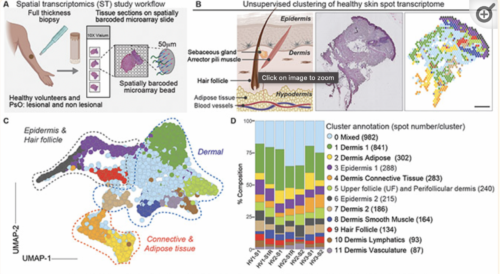Spatial transcriptomics stratifies psoriatic disease severity by emergent cellular ecosystems
June 02, 2023
Rochelle L Castillo, Ikjot Sidhu, Igor Dolgalev, Tinyi Chu, Aleksandr Prystupa, Ipsita Subudhi, Di Yan, Piotr Konieczny, Brandon Hsieh, Rebecca H Haberman, Shanmugapriya Selvaraj, Tomoe Shiomi, Rhina Medina, Parvathy Vasudevanpillai Girija, Adriana Heguy, Cynthia A Loomis, Luis Chiriboga, Christopher Ritchlin, Maria De La Luz Garcia-Hernandez, John Carucci, Shane A Meehan, Andrea L Neimann, Johann E Gudjonsson, Jose U Scher, Shruti Naik
Science Immunology
Whereas the cellular and molecular features of human inflammatory skin diseases are well characterized, their tissue context and systemic impact remain poorly understood. We thus profiled human psoriasis (PsO) as a prototypic immune-mediated condition with a high predilection for extracutaneous involvement. Spatial transcriptomics (ST) analyses of 25 healthy, active lesion, and clinically uninvolved skin biopsies and integration with public single-cell transcriptomics data revealed marked differences in immune microniches between healthy and inflamed skin. Tissue-scale cartography further identified core disease features across all active lesions, including the emergence of an inflamed suprabasal epidermal state and the presence of B lymphocytes in lesional skin. Both lesional and distal nonlesional samples were stratified by skin disease severity and not by the presence of systemic disease. This segregation was driven by macrophage-, fibroblast-, and lymphatic-enriched spatial regions with gene signatures associated with metabolic dysfunction. Together, these findings suggest that mild and severe forms of PsO have distinct molecular features and that severe PsO may profoundly alter the cellular and metabolic composition of distal unaffected skin sites. In addition, our study provides a valuable resource for the research community to study spatial gene organization of healthy and inflamed human skin.
